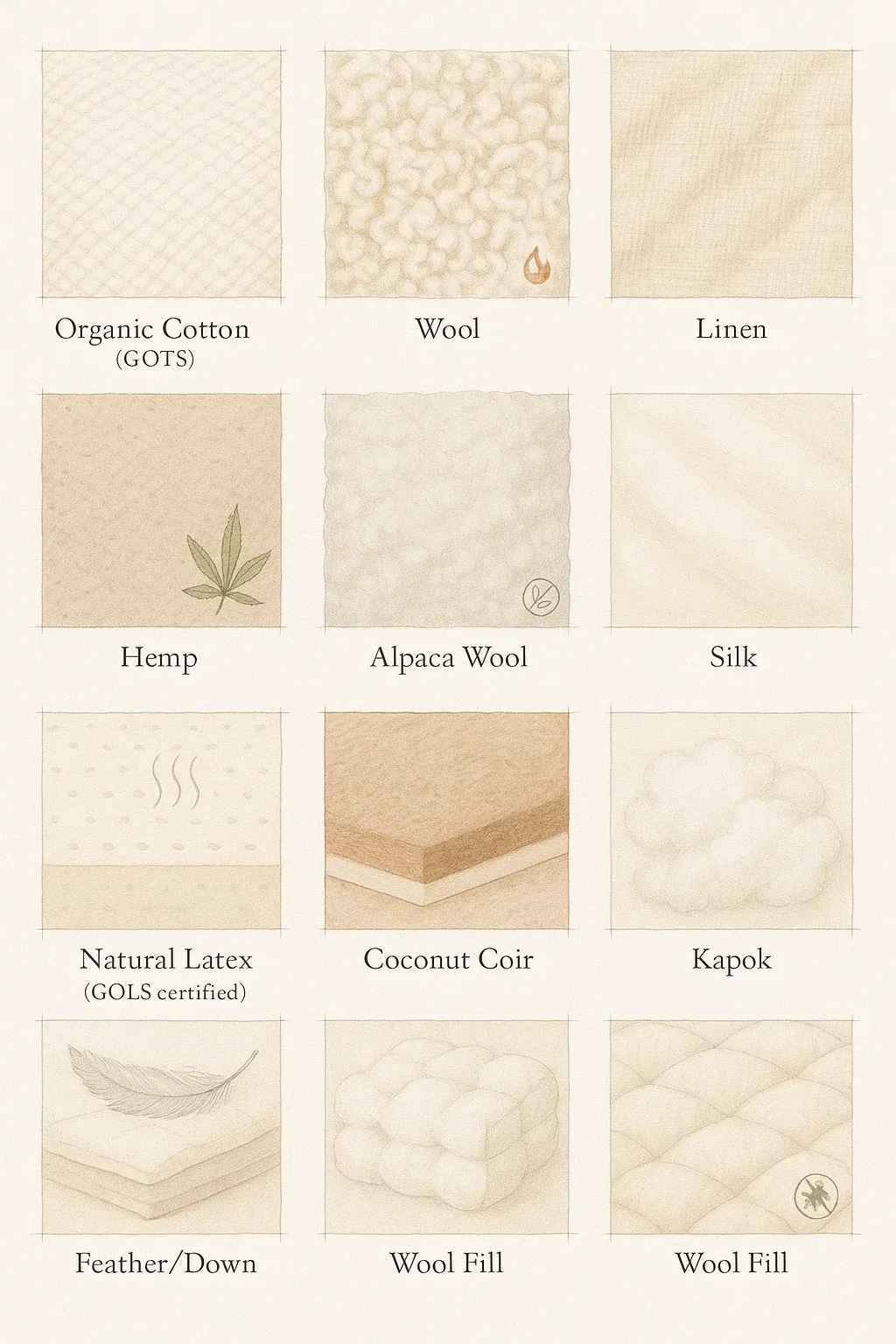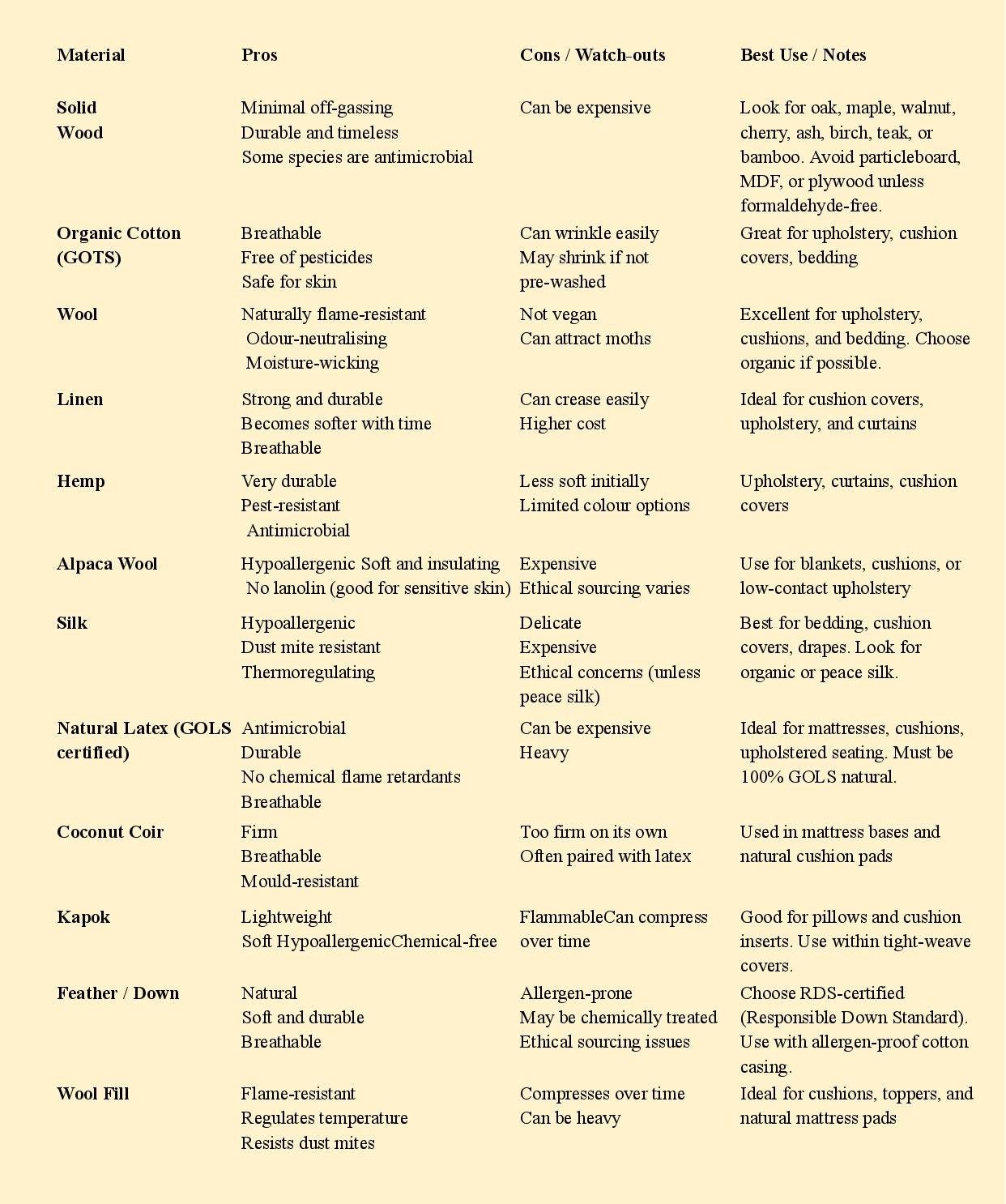In my last post, I shared the rather alarming reality of what's lurking in most modern furniture. You're probably looking around your living room with fresh eyes and wondering 'now what?'
So let's talk solutions. Real, practical, “I'm going furniture shopping this weekend” solutions.
The Materials That Actually Love You Back
When I'm evaluating furniture from a building biology perspective, I'm looking for materials that work with your body and your home's ecosystem, not against them.
Think of it as choosing housemates, you want the ones that contribute to a peaceful, healthy environment. Trust me, I once made the mistake of choosing the wrong housemate and it was a LONG nine months together until I was able to get him out.
The Healthiest Materials
✅ The Healthiest Materials: Pros & Cons Breakdown
Certifications That Actually Mean Something
Let me save you hours of research and tell you which certifications are worth your attention and which are basically marketing fluff.
Watch Out for These Greenwashed Labels
I can spot problematic furniture from across a showroom.
Here are the warning signs that should make you keep walking:
TB 117-2013 Compliant - This doesn't guarantee flame-retardant-free, especially on older inventory.
Soy Foam- Usually mostly polyurethane with a tiny bit of soy thrown in for marketing purposes.
Nontoxic without certification - Completely meaningless. Anyone can slap this label on anything.
Eco-friendly without specifics - Classic greenwashing. What exactly makes it eco-friendly?
Strong chemical smell - If it makes your eyes water in the showroom, imagine what it'll do in your enclosed living room.
Prices that seem too good to be true - Quality, non-toxic materials cost more. There's no getting around it. This is the one problem these days with everything being made out of China.
The Smart Shopping Strategy
Here's my step-by-step approach to furniture shopping that actually prioritises your health:
1️⃣ Research Before You Shop
Don't walk into stores blind. Use resources like the Center for Environmental Health's furniture database to identify brands that have already done the work of eliminating problematic chemicals.
2️⃣ Ask the Right Questions
If they can't answer these questions, they don't deserve your money.
3️⃣ Request Documentation
Any reputable manufacturer should be able to provide certification documents. If they hem and haw about "proprietary information," that's your cue to leave.
4️⃣ Consider Floor Models
Display pieces have been off-gassing in the showroom for months. If you find something you love, ask about purchasing the floor model - much of the initial chemical release has already happened.
5️⃣ Plan for the Transition Period
Even certified low-emission furniture may have some initial off-gassing. Plan delivery for when you can ventilate well, and consider using an air purifier with activated carbon during the first few weeks.
The Second-Hand Solution
Here's something most people don't consider: vintage and gently used furniture can be your healthiest option.
Pieces made before the 1970s predate most chemical treatments, and anything that's been around for a few years has completed its major off-gassing phase.
What to look for:
Solid wood construction (easier to assess when you can see wear patterns)
Natural materials that have aged well
Pieces that don't smell musty or chemical-y
How to refresh safely:
Sand wooden pieces outdoors with proper protection
Clean with simple solutions like white vinegar and baking soda
Reupholster with certified organic fabrics
When to Splurge vs. Save
Not every piece of furniture poses the same risk. Here's where I recommend investing in the highest quality, non-toxic options:
High Priority (splurge here):
Mattresses (you're sleeping on them 8 hours a night)
Sofas, beds and chairs (high contact, long sitting periods)
Children's furniture (higher vulnerability)
Dining tables (food contact surface)
Lower Priority (can be more flexible):
Decorative pieces with minimal contact
Storage furniture that's not upholstered
Outdoor furniture (better ventilation)
Let me be honest with you. furnishing a home with truly non-toxic pieces requires more research, more patience, and often more money than conventional shopping. It's not always convenient, and the selection isn't always as vast as big box stores. But at least that should make it easier to choose from as there are less options… we have to focus on the bright side.
Your Next Steps
Start small. You don't need to replace everything at once (and honestly, that would be wasteful and overwhelming).
Pick one piece, maybe that sofa you sit on every evening, or the mattress where you spend a third of your life , and make your next replacement a truly healthy choice.
And remember: every time you choose certified non-toxic furniture, you're not just protecting your own family's health but you're creating market demand that makes these options more available and affordable for everyone.
The future I envision, where furniture stores display chemical content alongside price tags, where interior designers are trained in material health, and where choosing non-toxic furniture is as normal as checking nutrition labels , starts with individual choices like yours.
Your living room should love you back. And now you know exactly how to make sure it does.
And if you're feeling overwhelmed by all this information, remember: perfect isn't the goal. Better is. Every small step toward a healthier home environment matters.










